[English] 日本語
 Yorodumi
Yorodumi- PDB-6anu: Cryo-EM structure of F-actin complexed with the beta-III-spectrin... -
+ Open data
Open data
- Basic information
Basic information
| Entry | Database: PDB / ID: 6anu | ||||||||||||
|---|---|---|---|---|---|---|---|---|---|---|---|---|---|
| Title | Cryo-EM structure of F-actin complexed with the beta-III-spectrin actin-binding domain | ||||||||||||
 Components Components |
| ||||||||||||
 Keywords Keywords | STRUCTURAL PROTEIN / actin binding protein / filament | ||||||||||||
| Function / homology |  Function and homology information Function and homology informationcerebellar Purkinje cell layer morphogenesis / structural constituent of synapse / postsynaptic spectrin-associated cytoskeleton / structural constituent of postsynapse / regulation of postsynaptic specialization assembly / spectrin / positive regulation of norepinephrine uptake / cellular response to cytochalasin B / regulation of transepithelial transport / morphogenesis of a polarized epithelium ...cerebellar Purkinje cell layer morphogenesis / structural constituent of synapse / postsynaptic spectrin-associated cytoskeleton / structural constituent of postsynapse / regulation of postsynaptic specialization assembly / spectrin / positive regulation of norepinephrine uptake / cellular response to cytochalasin B / regulation of transepithelial transport / morphogenesis of a polarized epithelium / paranodal junction / bBAF complex / postsynaptic actin cytoskeleton organization / protein localization to adherens junction / postsynaptic actin cytoskeleton / npBAF complex / Tat protein binding / brahma complex / structural constituent of postsynaptic actin cytoskeleton / nBAF complex / GBAF complex / regulation of G0 to G1 transition / dense body / Formation of annular gap junctions / Gap junction degradation / Cell-extracellular matrix interactions / Folding of actin by CCT/TriC / apical protein localization / regulation of double-strand break repair / regulation of nucleotide-excision repair / adherens junction assembly / actin filament capping / Prefoldin mediated transfer of substrate to CCT/TriC / RSC-type complex / RHOF GTPase cycle / Adherens junctions interactions / tight junction / Sensory processing of sound by outer hair cells of the cochlea / regulation of norepinephrine uptake / regulation of mitotic metaphase/anaphase transition / Interaction between L1 and Ankyrins / Sensory processing of sound by inner hair cells of the cochlea / parallel fiber to Purkinje cell synapse / SWI/SNF complex / positive regulation of double-strand break repair / regulation of synaptic vesicle endocytosis / positive regulation of T cell differentiation / apical junction complex / establishment or maintenance of cell polarity / adult behavior / cortical actin cytoskeleton / regulation of cyclin-dependent protein serine/threonine kinase activity / cortical cytoskeleton / maintenance of blood-brain barrier / positive regulation of stem cell population maintenance / NuA4 histone acetyltransferase complex / nitric-oxide synthase binding / Recycling pathway of L1 / regulation of G1/S transition of mitotic cell cycle / kinesin binding / brush border / calyx of Held / negative regulation of cell differentiation / positive regulation of double-strand break repair via homologous recombination / EPH-ephrin mediated repulsion of cells / RHO GTPases Activate WASPs and WAVEs / RHO GTPases activate IQGAPs / regulation of protein localization to plasma membrane / positive regulation of myoblast differentiation / COPI-mediated anterograde transport / vesicle-mediated transport / synapse assembly / EPHB-mediated forward signaling / substantia nigra development / MHC class II antigen presentation / NCAM signaling for neurite out-growth / axonogenesis / negative regulation of protein binding / cell projection / Translocation of SLC2A4 (GLUT4) to the plasma membrane / RHO GTPases Activate Formins / cell motility / actin filament / positive regulation of cell differentiation / regulation of transmembrane transporter activity / adherens junction / FCGR3A-mediated phagocytosis / Hydrolases; Acting on acid anhydrides; Acting on acid anhydrides to facilitate cellular and subcellular movement / DNA Damage Recognition in GG-NER / Signaling by high-kinase activity BRAF mutants / Schaffer collateral - CA1 synapse / MAP2K and MAPK activation / tau protein binding / B-WICH complex positively regulates rRNA expression / multicellular organism growth / structural constituent of cytoskeleton / phospholipid binding / Regulation of actin dynamics for phagocytic cup formation / kinetochore / nuclear matrix Similarity search - Function | ||||||||||||
| Biological species |  Homo sapiens (human) Homo sapiens (human) | ||||||||||||
| Method | ELECTRON MICROSCOPY / helical reconstruction / negative staining / cryo EM / Resolution: 7 Å | ||||||||||||
 Authors Authors | Wang, F. / Orlova, A. / Avery, A.W. / Hays, T.S. / Egelman, E.H. | ||||||||||||
| Funding support |  United States, 3items United States, 3items
| ||||||||||||
 Citation Citation |  Journal: Nat Commun / Year: 2017 Journal: Nat Commun / Year: 2017Title: Structural basis for high-affinity actin binding revealed by a β-III-spectrin SCA5 missense mutation. Authors: Adam W Avery / Michael E Fealey / Fengbin Wang / Albina Orlova / Andrew R Thompson / David D Thomas / Thomas S Hays / Edward H Egelman /  Abstract: Spinocerebellar ataxia type 5 (SCA5) is a neurodegenerative disease caused by mutations in the cytoskeletal protein β-III-spectrin. Previously, a SCA5 mutation resulting in a leucine-to-proline ...Spinocerebellar ataxia type 5 (SCA5) is a neurodegenerative disease caused by mutations in the cytoskeletal protein β-III-spectrin. Previously, a SCA5 mutation resulting in a leucine-to-proline substitution (L253P) in the actin-binding domain (ABD) was shown to cause a 1000-fold increase in actin-binding affinity. However, the structural basis for this increase is unknown. Here, we report a 6.9 Å cryo-EM structure of F-actin complexed with the L253P ABD. This structure, along with co-sedimentation and pulsed-EPR measurements, demonstrates that high-affinity binding caused by the CH2-localized mutation is due to opening of the two CH domains. This enables CH1 to bind actin aided by an unstructured N-terminal region that becomes α-helical upon binding. This helix is required for association with actin as truncation eliminates binding. Collectively, these results shed light on the mechanism by which β-III-spectrin, and likely similar actin-binding proteins, interact with actin, and how this mechanism can be perturbed to cause disease. | ||||||||||||
| History |
|
- Structure visualization
Structure visualization
| Movie |
 Movie viewer Movie viewer |
|---|---|
| Structure viewer | Molecule:  Molmil Molmil Jmol/JSmol Jmol/JSmol |
- Downloads & links
Downloads & links
- Download
Download
| PDBx/mmCIF format |  6anu.cif.gz 6anu.cif.gz | 527.7 KB | Display |  PDBx/mmCIF format PDBx/mmCIF format |
|---|---|---|---|---|
| PDB format |  pdb6anu.ent.gz pdb6anu.ent.gz | 417.9 KB | Display |  PDB format PDB format |
| PDBx/mmJSON format |  6anu.json.gz 6anu.json.gz | Tree view |  PDBx/mmJSON format PDBx/mmJSON format | |
| Others |  Other downloads Other downloads |
-Validation report
| Summary document |  6anu_validation.pdf.gz 6anu_validation.pdf.gz | 838.1 KB | Display |  wwPDB validaton report wwPDB validaton report |
|---|---|---|---|---|
| Full document |  6anu_full_validation.pdf.gz 6anu_full_validation.pdf.gz | 858.2 KB | Display | |
| Data in XML |  6anu_validation.xml.gz 6anu_validation.xml.gz | 70.9 KB | Display | |
| Data in CIF |  6anu_validation.cif.gz 6anu_validation.cif.gz | 112.7 KB | Display | |
| Arichive directory |  https://data.pdbj.org/pub/pdb/validation_reports/an/6anu https://data.pdbj.org/pub/pdb/validation_reports/an/6anu ftp://data.pdbj.org/pub/pdb/validation_reports/an/6anu ftp://data.pdbj.org/pub/pdb/validation_reports/an/6anu | HTTPS FTP |
-Related structure data
| Related structure data |  8886MC M: map data used to model this data C: citing same article ( |
|---|---|
| Similar structure data |
- Links
Links
- Assembly
Assembly
| Deposited unit | 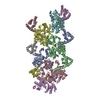
|
|---|---|
| 1 |
|
| Symmetry | Helical symmetry: (Circular symmetry: 1 / Dyad axis: no / N subunits divisor: 1 / Num. of operations: 20 / Rise per n subunits: 27.25 Å / Rotation per n subunits: -166.87 °) |
| Details | THE ASSEMBLY REPRESENTED IN THIS ENTRY HAS REGULAR HELICAL SYMMETRY WITH THE FOLLOWING PARAMETERS: ROTATION PER SUBUNIT (TWIST) = -166.87 DEGREES RISE PER SUBUNIT (HEIGHT) = 27.25 ANGSTROMS |
- Components
Components
| #1: Protein | Mass: 41782.660 Da / Num. of mol.: 6 Source method: isolated from a genetically manipulated source Source: (gene. exp.)  Homo sapiens (human) / Gene: ACTB / Production host: Homo sapiens (human) / Gene: ACTB / Production host:  #2: Protein | Mass: 32857.141 Da / Num. of mol.: 6 / Mutation: L253P Source method: isolated from a genetically manipulated source Source: (gene. exp.)  Homo sapiens (human) / Gene: SPTBN2, KIAA0302, SCA5 / Production host: Homo sapiens (human) / Gene: SPTBN2, KIAA0302, SCA5 / Production host:  |
|---|
-Experimental details
-Experiment
| Experiment | Method: ELECTRON MICROSCOPY |
|---|---|
| EM experiment | Aggregation state: FILAMENT / 3D reconstruction method: helical reconstruction |
- Sample preparation
Sample preparation
| Component | Name: F-actin complexed with the spectrin actin-binding domain Type: COMPLEX / Entity ID: all / Source: RECOMBINANT |
|---|---|
| Source (natural) | Organism:  Homo sapiens (human) Homo sapiens (human) |
| Source (recombinant) | Organism:  |
| Buffer solution | pH: 7.4 |
| Specimen | Embedding applied: NO / Shadowing applied: NO / Staining applied: YES / Vitrification applied: YES |
| EM staining | Type: NEGATIVE / Material: negative stain |
| Vitrification | Cryogen name: ETHANE |
- Electron microscopy imaging
Electron microscopy imaging
| Experimental equipment |  Model: Titan Krios / Image courtesy: FEI Company |
|---|---|
| Microscopy | Model: FEI TITAN KRIOS |
| Electron gun | Electron source:  FIELD EMISSION GUN / Accelerating voltage: 300 kV / Illumination mode: FLOOD BEAM FIELD EMISSION GUN / Accelerating voltage: 300 kV / Illumination mode: FLOOD BEAM |
| Electron lens | Mode: BRIGHT FIELD |
| Image recording | Average exposure time: 3 sec. / Electron dose: 20 e/Å2 / Detector mode: INTEGRATING / Film or detector model: FEI FALCON II (4k x 4k) Details: Images were stored containing seven parts, where each part represented a set of frames corresponding to a dose of ~20 electrons per Angstrom^2. The full dose image stack was used for the ...Details: Images were stored containing seven parts, where each part represented a set of frames corresponding to a dose of ~20 electrons per Angstrom^2. The full dose image stack was used for the estimation of the CTF as well as for boxing filaments. Only the first two parts were used for the reconstruction (~5 electrons per Angstrom^2). |
| Image scans | Movie frames/image: 7 |
- Processing
Processing
| Software | Name: PHENIX / Version: dev_2471: / Classification: refinement | ||||||||||||||||||||||||||||||
|---|---|---|---|---|---|---|---|---|---|---|---|---|---|---|---|---|---|---|---|---|---|---|---|---|---|---|---|---|---|---|---|
| EM software |
| ||||||||||||||||||||||||||||||
| CTF correction | Type: PHASE FLIPPING AND AMPLITUDE CORRECTION | ||||||||||||||||||||||||||||||
| Helical symmerty | Angular rotation/subunit: -166.87 ° / Axial rise/subunit: 27.25 Å / Axial symmetry: C1 | ||||||||||||||||||||||||||||||
| 3D reconstruction | Resolution: 7 Å / Resolution method: OTHER / Num. of particles: 12443 / Algorithm: BACK PROJECTION / Details: model-map FSC 0.38 cut-off / Symmetry type: HELICAL | ||||||||||||||||||||||||||||||
| Atomic model building | Space: REAL | ||||||||||||||||||||||||||||||
| Refine LS restraints |
|
 Movie
Movie Controller
Controller



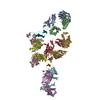

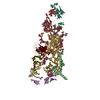

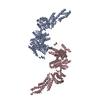
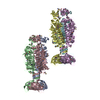
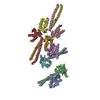
 PDBj
PDBj

























